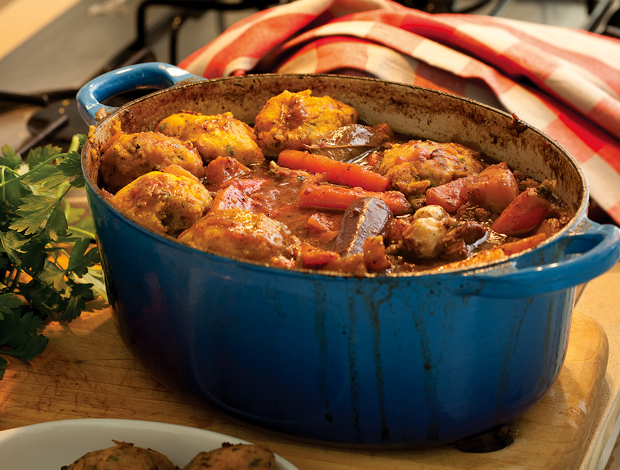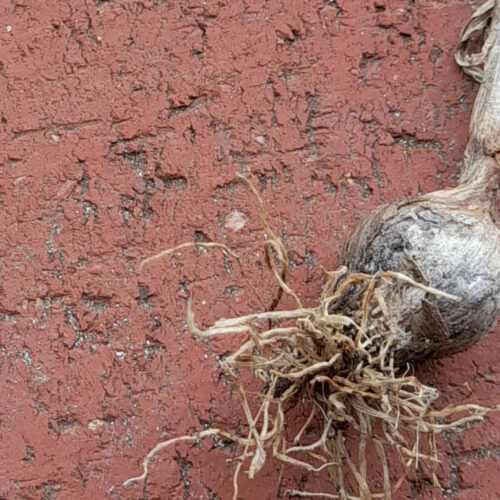Winter warmers
2013-06-29T12:02:34+10:00
Winter calls for warming, hearty fare – think tasty casseroles filled with just-picked root veggies. PHIL DUDMAN and JULIE RAY share their thoughts.
When root vegies mature, their flavours are more robust and they develop a thick skin (that’s life experience for you!) so they can be stored for longer.
Phil: So often, it’s the big bold brassicas that take all the glory in the winter garden, and deservedly so. But let’s not forget what lies beneath the ground – those earthy, unassuming root vegetables.
Despite their grubby and sometimes grotesque exterior, swedes, turnips, parsnips, carrots and celeriac are full of flavour on the inside, and often provide the backbone of warming winter dishes.
And there’s nothing better than stepping out to the patch on a chilly afternoon to pull up a few of these dedicated earth dwellers to toss into the pot. Unattractive, sure, but they are always welcome in my garden.
Julie: Young or old, they’re always welcome in my kitchen, too. Like many of us, when root vegies are young they are much easier on the eye: their skins are thin, which can mean no peeling necessary (just a good scrub) and the flavours are delicate. When they mature, their flavours are more robust and they develop a thick skin (that’s life experience for you!) so they can be stored for longer. Start harvesting young with the aim of spreading the harvest over a long period so that you always have plenty on hand for casseroles, soups, purees and roasts. It’s enough to warm you to your toes.
So, Phil, what’s for dessert?
Phil: When it comes to winter, I think of stewed fruit. There are so many fruits around at this time of the year. For starters, you have all the summer fruits in storage – such as apples and pears. Then there are the bottled stone fruits – apricots, peaches, plums and cherries.
In some areas, gardeners are still harvesting rhubarb, particularly those with well-established clumps. And in warmer zones, the first of ?the season’s strawberries are ready ?for picking.
Then, of course, citrus are in full swing with trees dripping with mandarins, oranges and lemons. Have I got you excited, Jules?
Julie: Oh yeah! Citrus zest and juice add a real zing to stewed fruit. When using bottled fruit, I just like to lay some into an oven-proof dish, sprinkle over some sugar and pop it into a warm oven for 10 minutes or so until the sugar is melted.
Even better, add a crowning glory of crumble – who could resist that? In the recipe that follows, I have added almond meal and almond flakes with a hint of cinnamon and vanilla. It’s guaranteed to fill your kitchen with a warm and cosy aroma.
“When root vegies mature, their flavours are more robust and they develop a thick skin (that’s life experience for you!) so they can be stored for longer.”
You can use any root vegetables in a casserole. It is about whatever is available. Choose tougher cuts of lamb like boneless shoulder, boneless forequarter, shanks and neck chops. They have more connective tissue that becomes tender and does not disintegrate when cooked slowly. They also tend to be more flavoursome in casseroles.
Root vegetable and lamb casserole with pumpkin dumplings
Serves 6-8
- 1 cup plain flour
- 1.5kg shoulder of lamb, diced into ?4cm cubes
- 5 tablespoons olive oil
- 40g butter
- 2 leeks, white part only, sliced
- 2 red onions, peeled and sliced
- 2 sticks celery, finely diced
- 4 cloves garlic, crushed
- 6 slices bacon rashers, finely diced
- 2 cups dry red wine
- 4 cups chicken stock
- 2 sprigs thyme
- 1 sprig rosemary
- 1 bay leaf
- 1 celeriac, peeled and cut into
- 2cm cubes
- 1 swede, peeled and cut into 2cm cubes
- 3 parsnips, peeled and quartered
- 6 baby turnips, cut in half
- 12 small carrots, peeled and quartered
- 2 tablespoons flat leaf parsley, chopped
Preheat oven to 170°C. Put flour into a large bowl and season generously with salt and pepper. Add the lamb cubes in batches, tossing to coat thoroughly.
In a large casserole dish, heat 1 tablespoon of olive oil over a high heat. Add a quarter of the lamb cubes and cook over a moderately high heat until browned on all sides, about 5 minutes, then transfer to a plate. Brown the remaining floured lamb in 3 batches, adding a tablespoon of oil to the pot per batch. Reduce the heat if the casserole dish bottom darkens too much. Once all batches of lamb are cooked, set aside.
Heat the remaining oil and butter in same pan over low heat. Add the leeks, onions, celery, garlic and bacon and cook, stirring, for 3-5 minutes until the onion is soft.
Add the wine, stock, herbs, lamb and juices. Cover the dish with a lid and place into the pre-heated oven and cook for 1.5 hours.
Add the root vegetables and cook covered for another hour. Lay the pumpkin dumplings (see recipe, right) on top of the lamb and vegetables, cover and cook for a further 15 minutes.
Remove casserole from the oven, sprinkle with parsley and serve in individual bowls with dumplings.
Pumpkin dumplings
Makes 12
- 1 cup self-raising flour, sifted
- 1 cup cooked pumpkin, mashed
- 1 teaspoon salt
- 2 teaspoons butter
- 1 tablespoon flat leaf parsley, finely chopped
- flour, extra for dusting
Combine all ingredients into a large bowl and mix to form a firm but slightly sticky dough. Divide into 12 round dumplings and dust lightly with extra flour.






